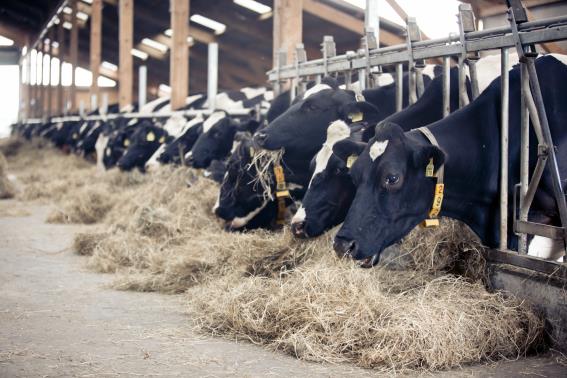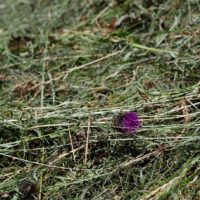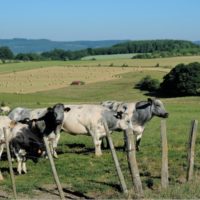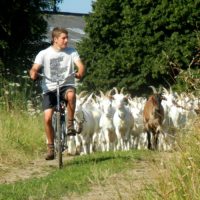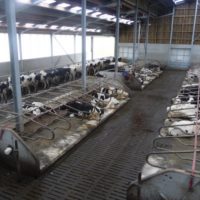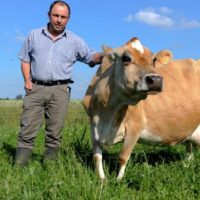Hay drying with warm air under the roof
Farm: “Hof Butendiek”
Location: Seefeld (Lower Saxony), Germany
Case study
 Hay drying with warm air under the roof (.pdf)
Hay drying with warm air under the roof (.pdf)
Description
Background
Since 1984 the family-owned farm Hof Butendieck is an organic farm. The marketing of organic products on a local scale is difficult, when there is no dairy plant in the surrounding area. This lead to the idea of direct marketing from the farm. In the beginning, the milk was manufactured on a small scale in the kitchen, which was a quite elaborate process. The milk was sold on weekly markets or directly via farm shop. Over a period of time, the products were further improved and developed until they were able to produce hay-milk to manufacture semi hard cheese. Hay-milk allows the intentional fermentation, which is not easily possible with cows feed by silage. Milk from cows feed by silage can contain butyric acid. This can cause cracking and ballooning cheese loafs. These cheese loafs are unsuitable for the market. Besides the aspect of product-safety there is a significant tastefulness with cheese produced from silage free milk. That is the reason to have two completely divided herds, which are held seperate during winter season. One group of cows is fed with silage, the other group is fed with hay as a feeding basis. All cows are allowed to pasture during summer season and are fed with hay, silage und concentrated fodder during winter season.
Today a vast amount of the produced milk of all 180 Holstein Frisian cows of the organic farm Hof Butendieck in Seefeld is processed to cheese and is distributed through food wholesalers, the farm shop and weekly markets. The wholesalers market cheese nationwide. Meanwhile there are various cream Cheese variants and a vast assortment of semi-hard cheese. Even though producing cheese comes with high amount of personnel und financial effort, it has the advantage of a higher value.
Farmer’s motivations
Hay as a feeding basis is much more challenging than wilted silage. Young grass in spring is energy rich and highly digestible, but due to not desirable weather conditions, it is often not possible to produce hay. In summer with long-term stable and dry weather conditions, the grass is older and stringy and therefore not in an optimal condition to produce milk. The divided cowherds (additional overheads and residual risks) together with forgone turnover due to silage feeding of some cows motivated the farmer to invest into hay drying. Now young grass beneficial to milk-production can be harvested and dried. During winter, all cows can be fed with hay because of sufficient hay forage. The risk of contamination of milk with butyric acid from silage is eliminated. Young cattle in other buildings can be fed further with cost-efficient silage. Another advantage of hay-production is, there are nearly no need for silage storage.
Hay drying as an innovation is the main guarantor of a safe and sustainable way of milking, profitable marketing and last but not least livelihood security for the organic farm.
Detailed description
In recent times on many farms, hay was dried in drying lofts with blowers. Increasing stocks, higher energy content in silage and increasing costs of energy triggered farmers to shift away from hay drying in large scale. Large drying lofts are highly unusual in Northern Germany, while they are quite common in in Southern Germany.
With high amounts of internal labour together with a renowned company, the farm built a combined drying- and storage-loft. Three drying compartments are filled with pre-dried grass and warm air is blown upwards through the grass. The needed air is taken from below the hall roof. This air below the hall roof is warmer due to solar radiation. The needed temperature increase is lower, so is the energy conservation. In all it is more climate protecting. On the long run, it is planned to use renewable energy sources like wind energy and photovoltaic systems as a basis for hay drying. When the intended degree of dryness is reached, the hay is transferred to a hay storage box und the next stack of hay can be dried.
Results
For the farm, there are three bullet points of enhancement: Young grass can be harvested a number of times a year. This causes higher harvest yields in energy and dry matter per Square unit. It is not necessary to have dry weather to produce hay, because the drying facility is available. Hence, the feeding basis for the winter period is secured. This is a major advantage, because weather uncertainty induced by climate change is no longer a thread. Hay is the foundation for feeding the cows at Hof Butendiek. The produced milk has to be butyric acid free to be of value for cheese production. Due to the new drying facility, the farm is able to produce enough hay to feed all cows during the winter period. This means protection of the cheese production and marketing at a high level of added value.
Adoption criteria
It is possible to apply hay drying in Northern Germany to other farms if they are willing to increase the added value. This is mainly the case in cheese production with a reasonable amount of direct marketing, as shown at Hof Butendiek. So-called hay milk as a classical milk produced by dairy plants does not have the needed increase in value to justify an investment into hay drying facilities.
Future prospects
In a stationary drying facility, a high amount of fossil energy is needed. In the future, renewable energy can be used to dry hay on a yearly climate-neutral basis.
Additional information
| Farming system | organic farming |
|---|---|
| Domains of innovation | forage conservation technique |
| Main types of animal | dairy cattle |
| Country | Germany |
| Product type | Case study |
| Language | English |

